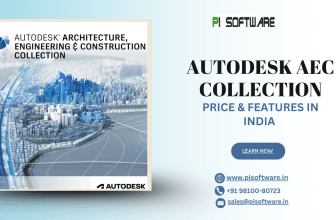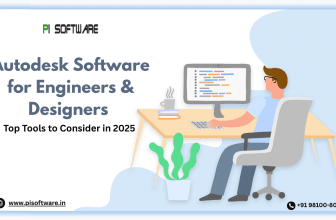Top 10 Autodesk CAD CAD CAM Software Solutions for Business Success

What is CAD-CAM Software?
CAD-CAM (Computer-Aided Design and Computer-Aided Manufacturing) software is a comprehensive computer program suite that assists professionals in various industries with creating, modifying, analyzing, and optimizing product designs. It seamlessly integrates design and manufacturing processes, providing a holistic solution that enhances efficiency and precision in the production pipeline.This powerful software has become synonymous with precision, versatility, and innovation, playing a pivotal role in a myriad of industries worldwide.The AutoCAD license structure plays a crucial role in how users access and utilize this powerful software. Here’s an overview of key aspects related to AutoCAD licenses:
Autodesk is a leading software provider renowned for its comprehensive suite of design, engineering, and entertainment solutions. Widely used in industries such as architecture, manufacturing, and media, Autodesk products, including AutoCAD, Fusion 360, and Maya, empowers professionals to create, simulate, and visualize their ideas. With cutting-edge tools and collaborative features, if you intersetd yo know about Autodesk Software Prices and supsciption plans then go with us. we are best resellers of Autodesk and many others softwares. Autodesk plays a pivotal role in driving innovation and efficiency across diverse sectors, making it an indispensable choice for businesses and creatives worldwide.
Key Features:
Computer-Aided Design (CAD):
CAD, the first component of CAD-CAM software, is dedicated to creating and modifying detailed and accurate digital representations of physical objects or systems. Designers and engineers use CAD tools to generate 2D and 3D models, allowing them to visualize and conceptualize their ideas before moving forward with the production. CAD software offers a range of features such as parametric modeling, assembly design, and simulation, empowering users to iterate through design concepts and optimize their creations.
Computer-Aided Manufacturing (CAM):
CAM, the second component, takes the digital designs created in CAD and translates them into machine-readable instructions for automated manufacturing processes. CAM software generates tool paths and instructions for CNC (Computer Numerical Control) machines, ensuring precise and efficient fabrication. By automating the manufacturing process, CAM software reduces the likelihood of errors, enhances consistency, and optimizes material usage.
Key Features of CAD-CAM Software:
- Integration: CAD-CAM software integrates seamlessly, allowing a smooth transition from design to manufacturing. This integration eliminates the need for manual data transfer, reducing errors and streamlining the overall production process.
- Parametric Modeling: CAD-CAM tools often incorporate parametric modeling, enabling designers to create models with defined parameters. This feature facilitates easy modification and updating of designs as project requirements evolve.
- Simulation and Analysis: The software includes simulation and analysis tools that enable users to virtually assess their designs’ performance, durability, and functionality. It aids in identifying potential issues before the manufacturing phase, saving time and resources.
- Toolpath Generation: CAM functionality involves the generation of tool paths for CNC machines. This process determines the precise movements and operations required for the tools to manufacture the designed components accurately.
- Collaboration: CAD-CAM solutions facilitate teamwork. Among the advantages of cloud-based platforms is that they make teamwork and communication more accessible and enable real-time sharing and editing of designs.
- Automation: Automation features in CAD-CAM software reduce manual intervention in design and manufacturing processes. It accelerates the workflow and minimizes the risk of human errors.
What is the difference between CAD and CAM?
CAD (Computer-Aided Design) and CAM (Computer-Aided Manufacturing) are two distinct but interconnected components of the product development and manufacturing process. They serve different purposes within the workflow, yet together, they form a powerful combination that streamlines the transition from design to physical production.
CAD (Computer-Aided Design):
CAD is the first stage in the process and focuses on creating and modifying detailed digital representations of physical objects or systems. Designers and engineers use CAD software to develop 2D and 3D product models. These models visually represent the design, allowing for conceptualization, analysis, and iteration before manufacturing begins.
Critical features of CAD include:
- Parametric Modeling: Parametric modeling is commonly featured in CAD tools, making it possible for users to adjust parameters easily to customize their design. This feature is crucial for iterative design processes.
- Visualization: CAD allows designers to visualize their concepts in a digital environment, providing a realistic preview of how the final product will look and function.
- Assembly Design: CAD software facilitates the creation of complex assemblies, enabling designers to understand how individual components fit together and interact within a more extensive system.
- Simulation and Analysis: CAD tools often include simulation and analysis features, allowing designers to assess the performance, durability, and other characteristics of their designs virtually.
CAM (Computer-Aided Manufacturing):
CAM, on the other hand, comes into play after the design phase. It focuses on converting the digital design created in CAD into machine-readable instructions for automated manufacturing processes. CAM software generates tool paths and instructions for CNC (Computer Numerical Control) machines, ensuring precision and efficiency in producing physical parts or products.
Critical features of CAM include:
- Toolpath Generation: CAM software determines the exact movements and operations required for the tools on CNC machines to manufacture the designed components accurately. It includes processes such as milling, turning, and drilling.
- Automation: CAM tools automate the manufacturing process, reducing the need for manual intervention. It not only speeds up production but also minimizes the risk of errors.
- Material Optimization: CAM software assists in optimizing material usage by generating efficient tool paths, reducing waste, and maximizing the yield from raw materials.
- Quality Control: CAM systems contribute to quality control by ensuring that the manufactured components match the specifications of the digital design, thereby maintaining consistency and accuracy.
Key Differences:
- Focus: CAD focuses on creating and modifying digital designs, whereas CAM concentrates on manufacturing and generating tool paths for production.
- Purpose: CAD is primarily for design visualization, analysis, and conceptualization, while CAM is for translating digital designs into instructions for machinery.
- Workflow: CAD and CAM work together sequentially, with CAD preceding CAM in the overall product development and manufacturing process.
Benefits of using licensed CAD-CAM Software
Using licensed CAD-CAM (Computer-Aided Design and Computer-Aided Manufacturing) software offers several advantages for businesses and professionals in design and manufacturing processes. While upfront costs may be associated with licensed software, the long-term benefits often outweigh the initial investment. Here are some key advantages of using licensed CAD-CAM software:
- Reliability and Support: Licensed CAD-CAM software is backed by the software provider, ensuring regular updates, bug fixes, and technical support. This reliability is crucial for maintaining a stable and efficient design and manufacturing environment. Users can rely on the software vendor for assistance in case of issues, ensuring smooth operations.
- Feature Richness: Licensed CAD-CAM solutions often have comprehensive features, tools, and functionalities. These advanced capabilities enable users to tackle complex design challenges, simulate real-world scenarios, and optimize manufacturing processes efficiently. Frequent updates from the software provider ensure access to the latest tools and technologies.
- Security and Compliance: Licensed software adheres to industry standards and compliances, providing a secure environment for handling sensitive design and manufacturing data. It is particularly crucial in industries where intellectual property and confidentiality are paramount. Licensed software often includes security measures and encryption protocols to protect valuable information.
- Vendor Integration: The software with licensed CAD-CAM systems from reputable vendors integrates seamlessly with other industry-standard solutions. This integration capability facilitates a smooth workflow, allowing users to collaborate efficiently, share data across platforms, and connect with other tools in the production pipeline.
- Regular Updates and Enhancements: With licensed software, users benefit from regular updates and enhancements the software vendor provides. These updates may include performance improvements, new features, and compatibility fixes. Staying current with the latest version ensures users can take advantage of technological advancements and maintain compatibility with evolving industry standards.
- Training and Resources: Licensed CAD-CAM software often includes extensive training resources, documentation, and educational materials. This support helps users, especially those new to the software, to quickly become proficient in using its features. Many software vendors offer training programs, webinars, and user forums to assist in skill development.
- Scalability: Businesses require CAD-CAM software that can accommodate their growing needs. As operations expand, users can quickly scale up their software usage or upgrade to more advanced versions offered by the vendor. This scalability ensures that the software meets the organization’s evolving requirements.
- Legal Compliance: Using licensed software ensures legal compliance and adherence to intellectual property laws. Unlicensed or pirated software use can lead to legal consequences, including fines and reputational damage. Licensed software users have the assurance that they are operating within the legal framework.
- Vendor Accountability: Licensed software comes with a level of accountability from the vendor. Users can expect timely support, assistance with troubleshooting, and a commitment to resolving issues. This level of responsibility is often absent in free or pirated versions of CAD-CAM software.
- Customization Options: Licensed CAD-CAM software often provides customization options to tailor the software to specific business needs. This flexibility allows users to adapt the software to their unique workflows, improving efficiency and productivity.
The Top 10 CAD CAM Software Solutions
Here, we explore the top 10 CAD CAM software solutions that stand out, providing businesses with the tools they need to thrive in today’s dynamic environment.
- AutoCAD: A pioneer in the field, AutoCAD remains a powerhouse for 2D and 3D design. Its intuitive interface and comprehensive features make it a go-to solution for professionals across various industries.
- SolidWorks:Renowned for its parametric modeling capabilities, SolidWorks is a go-to solution for mechanical design and engineering. Its versatility and collaborative features make it a staple in product development.
- Fusion 360: Autodesk’s Fusion 360 is a cloud-based platform integrating CAD, CAM, and CAE. It provides a collaborative environment for design and manufacturing teams, fostering innovation and efficiency.
- CATIA: Widely used in the aerospace and automotive industries, CATIA is known for its advanced surface modeling and parametric design. It is a robust solution for complex product development.
- Mastercam: Focused on precision machining, Mastercam is a CAM software that excels in creating tool paths for milling and turning. Its comprehensive tool library and simulation features contribute to its popularity.
- Rhino: Rhino is a versatile 3D modeling software known for its flexibility in creating organic shapes and free-form designs. It is trendy among architects and industrial designers.
- SOLIDCAM:Integrated seamlessly with SolidWorks, SOLIDCAM is a CAM solution that simplifies the programming of CNC machines. Its automation features enhance efficiency in the manufacturing process.
- Creo: Formerly known as Pro/ENGINEER, Creo offers parametric 3D CAD modeling and simulation tools. It is a comprehensive solution suitable for a wide range of industries.
- Onshape: A cloud-based CAD platform, Onshape facilitates real-time collaboration among design teams. It eliminates the need for installations and updates, streamlining the design process.
- NX (Unigraphics): Siemens NX, formerly known as Unigraphics, is a comprehensive solution that spans CAD, CAM, and CAE. It is widely used in industries requiring complex and integrated design and manufacturing processes.
Conclusion :-
In summary, CAD-CAM software is pivotal in modern design and manufacturing, offering a unified platform for creating, analyzing, and producing intricate products.
Investing in the right CAD CAM software is a strategic decision that can significantly impact a business’s efficiency and competitiveness. By leveraging the capabilities of these top 10 solutions, companies can confidently navigate the complexities of modern design and manufacturing, ultimately paving the way for sustained success in their respective industries. When you Buy AutoCAD license, you unlock a world of robust design and drafting capabilities. Whether you’re an architect, engineer, or designer, an AutoCAD license provides industry-standard tools to create precise 2D and 3D designs.






